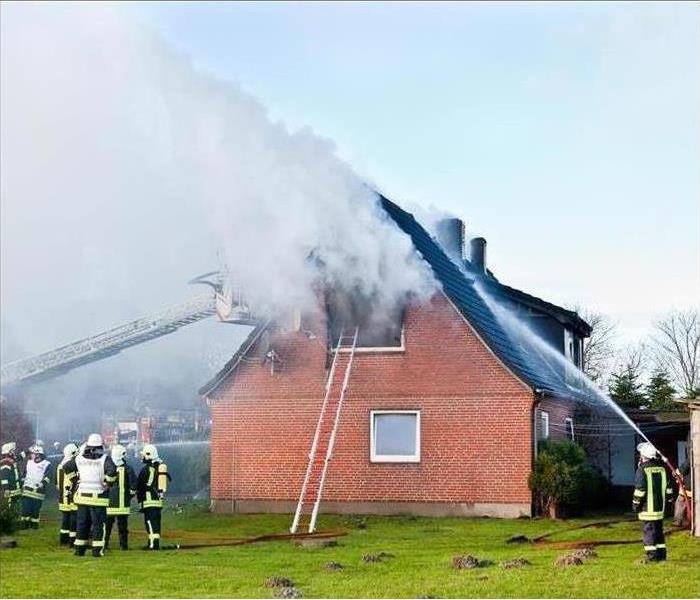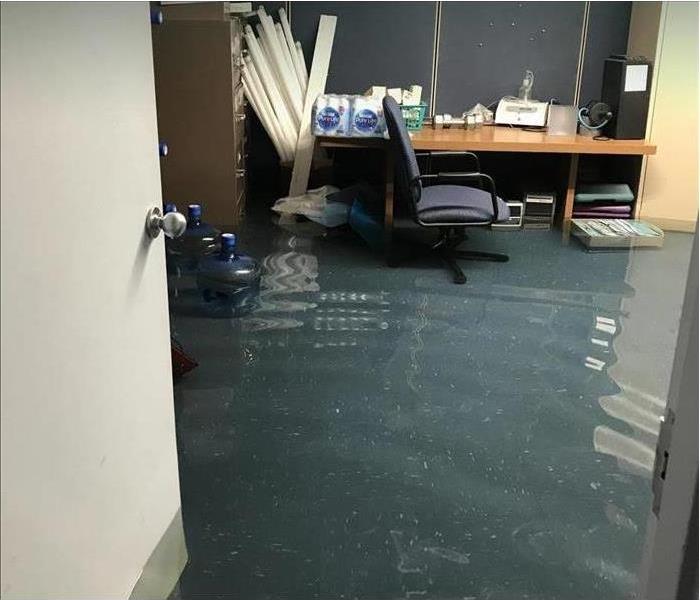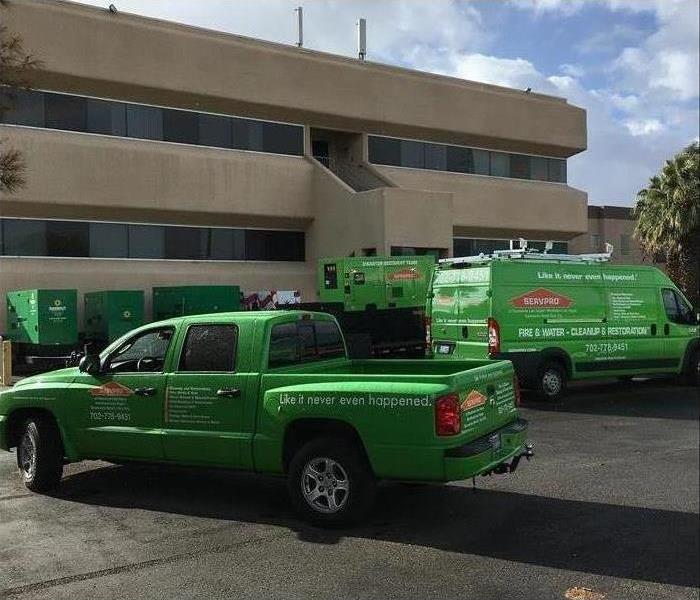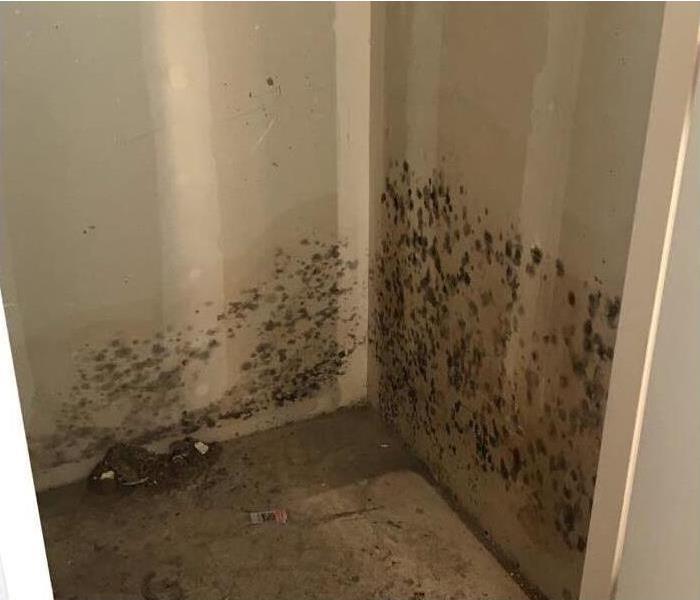Archived Why SERVPRO Blog Posts
What Are the Risks of Flooding After a Fire?
7/31/2022 (Permalink)
 Water damage from fire suppression in Northwest Las Vegas, NV
Water damage from fire suppression in Northwest Las Vegas, NV
What Threats Do Floods After a Fire Pose?
Fire and flooding damage may seem like unrelated issues, but flooding or water damage can follow a fire and intensify primary damage. Find out more about flood risks posed by different types of fires and how the Federal Emergency Management Agency's National Flood Insurance Program, also known as FEMA NFIP, can help with wildfire damage.Water Damage From Fire Suppression
Regardless of the cause of a fire, fire suppression methods are likely to result in water damage.
- Fire hoses dispense anywhere from 300 to 800 gallons of water per minute.
- Firefighting efforts can grind in ash and soot.
- A structure with fire damage may become flooded.
Damage resulting from fire suppression should be covered by homeowner's insurance. Document the damage before taking mitigation measures.
Flooding Resulting From Wildfires
The risk of flash flooding and mudflows can be elevated for up to five years after a wildfire.
- Wildfires char the ground, limiting the ability of soil to absorb rainfall.
- Fires eliminate vegetation that anchors soil.
- Unabsorbent ground increases runoff.
Most homeowners' insurance policies exclude flooding damage. Homeowners in affected areas should obtain FEMA NFIP coverage.
Combined Fire and Water Damage
Standing water from flooding or fire suppression efforts worsens fire damage. Mitigation may involve:
- Eliminating water with a pump or wet vac.
- Preventing ash and soot from getting ground into hard flooring.
- Tearing out and replacing porous materials, such as carpet.
Depending on the source of the flood water, specialized cleaning methods may be used to eliminate signs of fire and water damage from certain contents or surfaces. Cleanup specialists will recommend the right restoration measures.
Rely on fire, flood, and water damage mitigation experts to restore a residence following fire suppression efforts or wildfire-related flooding in Northwest Las Vegas, NV. Residents should document damage and file a claim with the FEMA NFIP or homeowner's insurance providers to offset cleanup and restoration expenses.
4 Steps To Deal with Water Damage
6/27/2022 (Permalink)
 Water damage in an office in Las Vegas, NV.
Water damage in an office in Las Vegas, NV.
Four Steps to Handle Water Damage
Any commercial property Las Vegas, NV, is susceptible to water damage. From broken pipes to foundation issues or a roof leak, any water issue requires immediate attention. After calling your insurance company to get the claim process started, there are four essential steps to take to minimize the damage.
1. Determine the Extent of Damage
The moment unwanted water is discovered, it is essential to find the source of the problem and the extent of the damage. If the cause is a burst pipe, stopping the water simply means turning off the main water supply. If it is a slow leak in the roof or foundation, the fix will not be as easy and may have likely already caused more damage than is visible. Using a water meter is a good way to determine how far the water has spread. With this information in hand, the specific cleanup needs will be easier to determine.
2. Document Everything
As you complete the initial inspection, it is recommended to take videos and photographs of all the associated water damage. Along with providing a better idea of what repair and restoration services may be required, it also helps the claims process go more smoothly by offering a clear picture of every item that has been damaged, making it easier for both the insured and insurer to create a plan of action.
3. Begin Water Extraction and Drying Processes
The sooner standing water is extracted the better. After sitting for 48 hours, the odds of having to replace more belongings and structural components and deal with mold growth increase dramatically. While a wet-dry vacuum is helpful, it may be worth renting an industrial-grade pump to speed up the process. Once the water is extracted, it is time to dry out the property and affected items. Fans and dehumidifiers are key tools to a faster dry time. During this process, it is important to keep the affected area sealed off to prevent the chances of the damage spreading.
4. Contact a Water Cleanup Specialist
When it comes to water issues, time is of the essence. Luckily, there are certified water mitigation and restoration professionals that are Faster to Any Size Disaster. Not only will a SERVPRO team be on-site to assist within 48 hours, but the team will also have the expertise to begin the essential water extraction process while working with the insurance provider to ease the claims process. With a focus on restoring and not replacing, this dedicated team has an arsenal of cleaning and restoration methods to ensure the claim is maximized for all parties involved. Since it is a one-stop-shop for every step of the process, it means gaining the confidence that the work will be completed as timely as possible with no hidden surprises.
Dealing with water damage is, unfortunately, a common issue and one that will likely arise at some point in time. Taking immediate steps to minimize the damage and working with a professional company that is an expert in the field and well-versed in the insurance industry makes the cleanup easier for everyone.
How Hiring a Disaster Recovery Team Can Get You Back to Business Faster
4/26/2022 (Permalink)
 SERVPRO of Northwest Las Vegas was quick to respond and start extracting water from the facility.
SERVPRO of Northwest Las Vegas was quick to respond and start extracting water from the facility.
How Hiring a Disaster Recovery Team Can Help You Recover More Quickly
Disaster can strike at any moment with little notice and destroy your business. The time it takes to clean and restore your commercial space is time you should be serving your customers and taking care of your employees. You want a disaster recovery team on standby that can handle major storm damage restoration quickly and efficiently so you can return to your regular operations as soon as possible.
Recovery Teams Are Trained Specialists
When your business is damaged during a storm or event, you need to know that the recovery service you call is qualified to recognize and address the major issues you may be facing. If not properly treated, you could be facing long-term health and safety issues associated with events such as:
Make sure the technicians you hire to clean and restore your space have specialized, professional training in water damage restoration and structural drying methods.
No Job Is Too Big for Them
When your local area is affected by a major event, you may feel overwhelmed by the damage not only to your property but also to the community at large. However, a professional restoration service is prepared with qualified and experienced production managers ready to take on large projects like hotels, universities and government buildings. Know that your business is in good hands when the next tornado, hurricane, or wildfire upsets your bottom line.
They Provide Emergency Service Around the Clock
In urgent situations, waiting to contact professional cleaning and restoration services only leads to greater damage. For water and flooding emergencies, disaster recovery services offer strategically convenient locations with 24/7 availability, so you can expect immediate action to combat further damage. You’ll want a service like SERVPRO to provide storm response that is Faster to any size disaster.
Storms, fires and other catastrophes are stressful, but they don’t have to be devastating. As a business owner in Northwest Las Vegas, NV, you need a disaster recovery team dedicated to providing local businesses with resources after major losses so you can get back to work as quickly as possible.
Combating Fungus: Controlling Mold Growth in Your Home
1/23/2022 (Permalink)
 Mold damage in a Northwest Las Vegas, NV home.
Mold damage in a Northwest Las Vegas, NV home.
Controlling Mold Growth in Your Home
While mold damage can occur relatively quickly, most structural harm will come from prolonged instances of moisture buildup. Therefore, to prevent and control the level of mold development in your home, it may be necessary to perform regular inspections as well as install and maintain proper preventative measures.
1. Controlling Humidity
Mold and mildew growth are tied directly to moisture. One of the most advantageous times of the year for this type of fungus is in the warmer summer months when humidity is high. Therefore, as an extra layer of protection, you may want to install dehumidifiers around your home, especially in your basement and possibly attic where moisture levels are typically highest.
2. Ventilating High Moisture Areas
Extensive mold damage can be prevented in areas like bathrooms, kitchens and laundry rooms by using proper ventilation. You can install ceiling fans and even ductwork that vents to the outside to minimize the amount of remnant moisture in these areas.
3. Sealing Your Home
A lot of mold growth occurs around windows, doors and even rooflines. You can inspect these areas, looking for signs of sealant wear and tear. If you come across areas of yellowing or cracked caulk lines, it is in your best interest to replace the caulk before dampness infiltrates your framing and home interior.
4. Inspecting and Resolving Home Repair Issues
While surface inspections are easy enough, it can be beneficial to have annual inspections of your home to ensure that there are no hidden problems. You can call a mold remediation specialist in the Northwest Las Vegas, NV, area to have your home assessed for possible damage. Many of these companies will offer a free assessment of your property and even provide you with a preventative plan.
Mold damage can be a costly problem that seems to come from nowhere but being vigilant about moisture control can minimize those risks. Installing dehumidifiers and ventilation systems can eliminate most environmental moisture problems. Also, scheduling regular inspections can help pinpoint issues before significant repairs are needed.





 24/7 Emergency Service
24/7 Emergency Service



